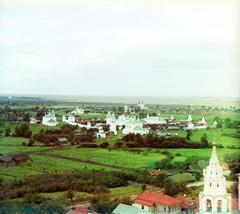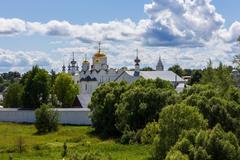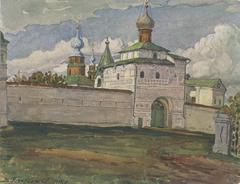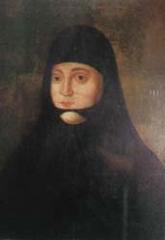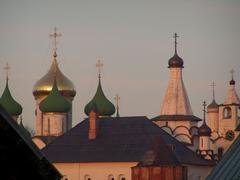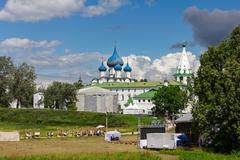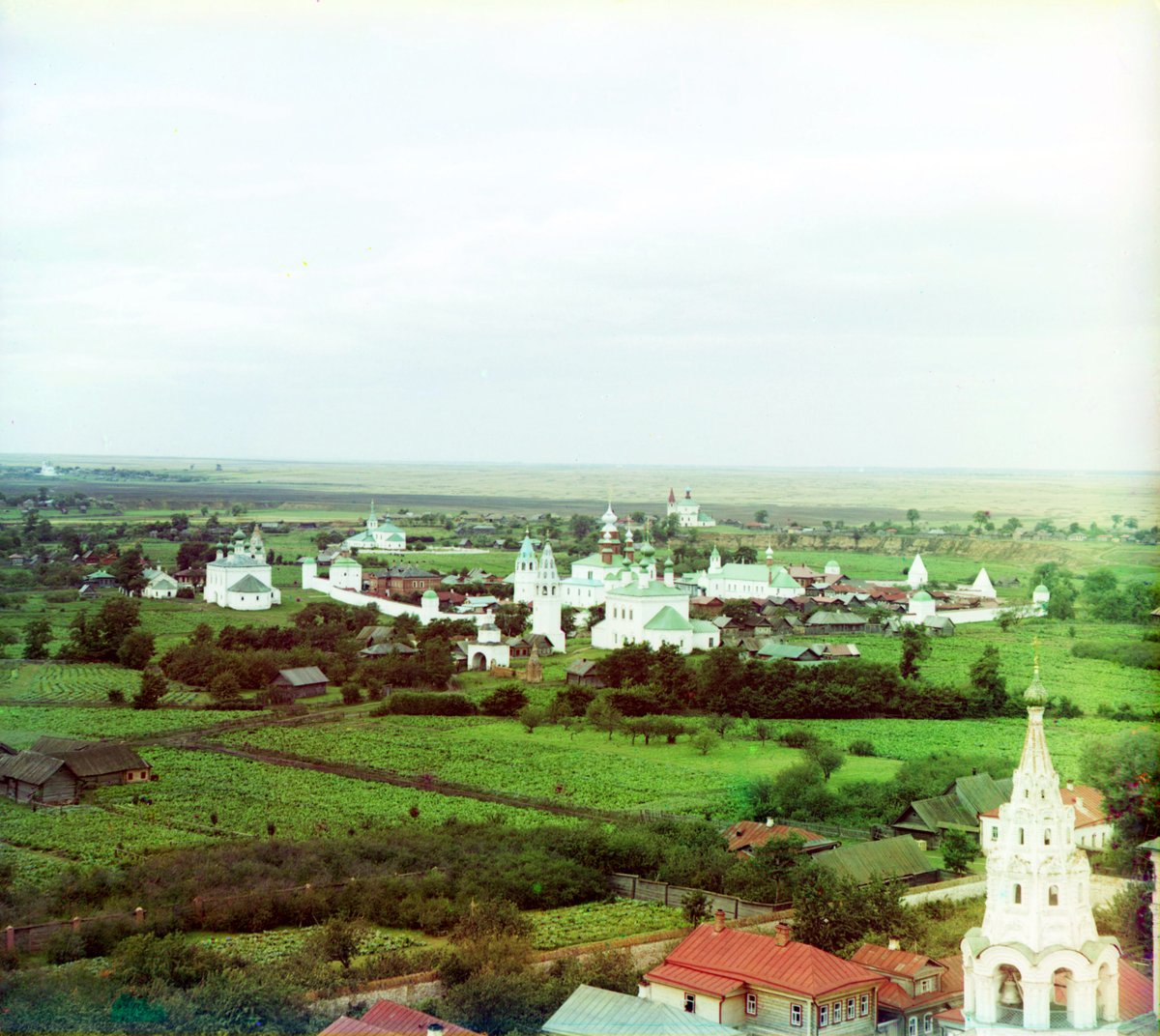
Pokrovsky Monastery Suzdal: Visiting Hours, Tickets, and Detailed Travel Guide
Date: 14/06/2025
Introduction
Set on the tranquil banks of the Kamenka River in Suzdal, Russia, Pokrovsky Monastery—also known as the Convent of the Intercession—stands as an enduring symbol of Russia’s religious, architectural, and cultural legacy. Founded in 1364, this functioning Russian Orthodox convent draws visitors with its striking white-stone cathedrals, storied past, and serene landscapes that exemplify the historical core of Russia’s Golden Ring region. Beyond its spiritual importance, the monastery is notable as a place of exile for noblewomen, a repository of exquisite frescoes and icons, and a site that has weathered periods of decline and revival.
This guide provides a comprehensive overview of Pokrovsky Monastery’s rich history, architectural highlights, visiting hours, ticketing, tours, and travel tips. You’ll also find practical advice for accessibility, etiquette, and nearby attractions to ensure a fulfilling experience—whether you are a pilgrim, history buff, or cultural traveler (ermakvagus.com; atomiyme.com; Trip101; Russia Beyond; visitrussia.com).
Historical Overview
Foundation and Early Development (14th–15th Centuries)
Pokrovsky Monastery was established in 1364 by Prince Dmitry Konstantinovich of Suzdal. According to legend, after surviving a perilous storm, Prince Andrey Konstantinovich vowed to build the monastery, thus marking its spiritual origins (ermakvagus.com; atomiyme.com). The monastery began as a small wooden complex, its humble presence accentuated by the peaceful riverbank setting.
Renaissance under Vasily III (Early 16th Century)
The early 16th century ushered in a period of architectural and spiritual flourishing under Grand Prince Vasily III of Moscow. Key constructions from this era include:
- Pokrovsky (Intercession) Cathedral (1510–1518): A monumental white-stone structure featuring a two-story open gallery and covered staircases.
- Holy Gates and Gate Church of the Annunciation (1518): Serving both as an entrance and a place of worship.
These additions combined ancient Russian and Western European design elements, establishing the monastery’s iconic appearance (atomiyme.com).
Monastery as a Place of Exile for Noblewomen
From the 16th century, Pokrovsky Monastery became known as a site of monastic exile for noblewomen, most famously Solomonia Saburova, wife of Vasily III, who was confined here and later canonized as St. Sophia of Suzdal. The monastery’s crypts hold the remains of several royal and noble women, underscoring its historical importance (ermakvagus.com).
Expansion, Decline, and Soviet Era
The 16th–18th centuries saw further expansion, including the addition of the Conception Church, a refectory, and unique monastic kitchen. The monastery faced decline and eventual closure in 1923 following the Bolshevik Revolution. During the Soviet era, it was repurposed as a secret police laboratory and later as a museum and tourist attraction. Restoration in the 20th century preserved its core structures, and religious life was revived in 1992 when the monastery was returned to the Russian Orthodox Church (atomiyme.com).
Architectural Features
Layout and Setting
Pokrovsky Monastery is set amidst open pastures and gardens, harmoniously blending with the Suzdal landscape (Trip101). Unlike fortified monasteries, its modest defensive walls reflect its function as a convent. The ensemble includes:
- Pokrovsky Cathedral with its signature onion domes and whitewashed walls
- Gate Church and Holy Gates
- Conception Church and Refectory
- Bell Tower and monastic cells
Traditional Russian construction techniques, decorative kokoshniks, and ornamental brickwork unify the architectural composition (Russia Beyond).
Preservation Efforts
Restorations in the 19th and 20th centuries introduced Russian Revival elements while safeguarding the monastery’s heritage. Today, Pokrovsky Monastery is recognized as one of the best-preserved monastic sites in the Golden Ring and contributes to Suzdal’s UNESCO World Heritage status (OrexCA).
Cultural and Religious Significance
Role in Russian Orthodoxy
The monastery is a vital center of Orthodox worship and pilgrimage, particularly for women. It houses relics of St. Sophia of Suzdal and attracts worshippers seeking spiritual solace and healing (Trip101).
Connection to Russian Nobility
Serving as both sanctuary and exile for noblewomen, Pokrovsky Monastery’s archives and crypts preserve stories central to Russia’s royal and noble history.
Artistic Heritage
The monastery features exquisite icons, frescoes, and religious objects, contributing significantly to Russian artistic and spiritual traditions. Its peaceful environs and artistic treasures have inspired countless works of literature and art (OrexCA).
Visiting Pokrovsky Monastery: Practical Information
Visiting Hours
- April–October: 9:00 AM – 7:00 PM
- November–March: 10:00 AM – 5:00 PM
- Sundays & Major Feasts: Extended hours; check ahead for changes.
Tickets and Admission
- Grounds: Free entry; donations welcomed.
- Cathedral, Museums, Guided Tours: 150–300 RUB. Purchase on-site or via Suzdal Tourism Portal.
- Children under 7: Free.
Accessibility
Main paths and cathedral are wheelchair accessible, though some historic areas have uneven surfaces. Contact the monastery in advance for special assistance.
Guided Tours
Daily tours in Russian and English provide historical context and spiritual insights. Advance booking is recommended in peak season.
Dress Code and Etiquette
- Modest attire required (shoulders/knees covered)
- Women: headscarves; men: no shorts/sleeveless shirts
- Silence and respect in sacred areas
Photography
Allowed outdoors; ask for permission inside churches, especially during services.
Facilities
- Restrooms and café at the entrance
- Souvenir shop with local crafts
- Some monastic cells offer simple guest accommodation (visitrussia.com)
Getting There
- From Suzdal Center: 20–25 minute walk or short taxi/bus ride
- From Moscow: Train to Vladimir, then bus/taxi to Suzdal (expresstorussia.com)
- Parking: Available near the monastery
Activities and Experiences
- Museum Exhibits: Explore religious artifacts, icons, and the convent’s history (russiatrek.org).
- Workshops: Photography and choral music workshops offered seasonally (travelsetu.com).
- Seasonal Events: Major feasts (e.g., Intercession of the Virgin, October 14) with processions and liturgies.
- Mindfulness Retreats: Occasional spiritual retreats in a contemplative setting.
Nearby Attractions
Combine your visit with:
- Suzdal Kremlin: UNESCO site and historical fortress
- Museum of Wooden Architecture: Traditional Russian buildings
- Spaso-Yefimiev Monastery: Fortified monastery with museums
All are within easy reach for a full day of Suzdal exploration (Trip101).
FAQ
Q: What are the current visiting hours?
A: Generally 9:00 AM–7:00 PM (April–October), 10:00 AM–5:00 PM (November–March); check ahead for holiday hours.
Q: Is there an entrance fee?
A: Grounds are free; tickets (150–300 RUB) are needed for specific areas/tours.
Q: Are English-language tours available?
A: Yes; book in advance, especially in summer.
Q: Is the site accessible for people with disabilities?
A: Main paths and the cathedral are accessible; some historic areas may pose challenges.
Q: Can I take photos inside?
A: Yes, outdoors. Indoors, permission is required.
Preservation, Education, and Community
Pokrovsky Monastery is committed to preservation and community outreach, offering educational programs, hosting festivals, and supporting local charitable initiatives.
Travel Tips
- Best times: Spring and early autumn for mild weather and fewer crowds
- Dress modestly: Respect religious customs
- Visit early: For a quieter and more contemplative experience
- Bring cash: For donations, tickets, and souvenirs
Plan Your Visit
For official information, tickets, and event updates, visit the Official Pokrovsky Monastery Website or Suzdal Tourism Portal. Enhance your journey with guided tours and explore more of Suzdal’s historical wonders.
Summary
Pokrovsky Monastery in Suzdal offers a profound connection to Russia’s spiritual and noble heritage. With its evocative architecture, sacred relics, and tranquil riverbank location, the monastery is a highlight of the Golden Ring and an essential stop for cultural and religious travelers. Plan ahead, respect local customs, and immerse yourself in this remarkable site where centuries of history, faith, and artistry converge (pokrovsky-monastery.ru; suzdal.travel; ermakvagus.com).
Sources
- Pokrovsky Monastery in Suzdal: History, Visiting Hours, Tickets, and Travel Tips
- Pokrovsky Monastery History and Interesting Facts
- Things to Do in Suzdal Russia
- Suzdal Golden Ring Travel Guide
- The Pokrovsky Convent in Suzdal
Enhance your trip by downloading the Audiala app for curated tours and insider tips on Suzdal and Russia’s Golden Ring. Follow us on social media for updates and exclusive content.
